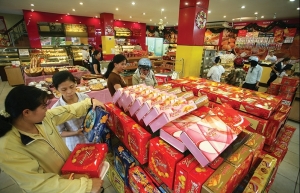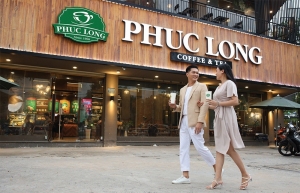Seizing opportunities in F&B
What is the development potential of Vietnam’s F&B market?
The potential remains vast, and the battle for acquiring consumers is more vibrant than ever, not only among food services but also among retailers and manufacturers.
 |
| Dang Thuy Ha, director of Consumer and Marketing Insights at NielsenIQ |
The NielsenIQ Food Trip 2024 report conducted in the major cities of Hanoi and Ho Chi Minh City, with a sample size of 700, observed that due to busy lifestyles and the increasing living standards of Vietnamese people, eating out is no longer reserved for special occasions but has become a habitual practice.
The average expenditure per meal for a consumer when dining out has increased approximately threefold compared to pre-pandemic times, and the growth rate has reached a double-digit figure compared to last year.
This trend is not only driven by the diversity of menus from various rich culinary traditions but also by the emergence of new restaurant brands and different retail channels. All these factors have provided consumers with countless options for dining experiences outside their homes.
What factors are directly affecting the F&B market and the operations of businesses?
The market is influenced by various factors, and some important ones directly impacting the operations of businesses include changes in consumer behaviour, the impact of digital transformation and e-commerce, as well as the increasing prioritisation of health and food safety. Moreover, macroeconomic factors have also been significant influences on the industry.
We have been closely monitoring consumer behaviour in the F&B industry for many years and have observed significant changes in consumers’ reasons for choosing dining destinations as well as their habits and experiential evaluations. Following the pandemic, especially with the economic fluctuations in 2024, consumer behaviour changes have become increasingly evident, exerting a significant influence on the market.
Additionally, the Gen Z customer segment is increasingly growing in the market. They possess distinct characteristics and preferences compared to previous generations, such as autonomy and independence, and are easily drawn to unique and novel experiences.
How does NielsenIQ assess consumer trends in F&B and what recommendations do you have for those in the sector?
According to the 2024 report, consumer behaviour in the F&B industry is currently diverse, complex, and evolving within specific segments. One notable highlight is the strong preference for comfortable dining experiences, as consumers frequently visit such venues for family meals or gatherings with friends.
According to our survey, the two most visited options by consumers in the past month have been budget-friendly eateries and fast-food restaurants. The visitation rate to fast-food restaurants has increased by over 40 per cent compared to pre-pandemic times, while choices such as convenience stores and bubble tea shops have also undergone noticeable changes.
F&B businesses undoubtedly face significant competitive pressures. To draw in and retain consumers, we recommend that businesses pay special attention to understanding the thoughts and emotions of consumers.
For example, understanding customer emotions is a crucial step in building a strong relationship between the brand and customers. Grasping customer behaviour helps us understand preferred channels and where they are willing to spend more, enabling us to identify effective revenue-generating channels.
Developing the brand aims to increase the visibility of any given brand across various media channels, helping to prioritise activities for overall interaction. The recognition of the top five leading brands shows a big gap with the brands ranked behind them.
Ensuring quality is also an essential factor in satisfying customers. In reality, some brands have received a significantly higher referral rate, even nearly double that of other brands, indicating a clear differentiation in satisfaction levels. Flexibility and the ability to quickly grasp trends will also be crucial factors.
 | Exciting times ahead in F&B and FMCG Vietnam’s mergers and acquisitions market is abuzz in food and beverages, as well as in consumer goods, as the competitive landscape evolves and rivals reshape their portfolios. Van Thu reports. |
 | Food and beverages move with the times The Vietnamese food and drink mergers and acquisitions market has shown more robust activity in the early months of 2021, with investors buoyed by the market outlook. |
 | Mapping Vietnam’s F&B on the gastronomic map While the economy remains uncertain for 2024, we anticipate positive developments in the hospitality and food and beverages (F&B) market, particularly within the luxury segment. |
 | F&B still attractive for players old and new The food and beverages market in 2024 is expected to become more competitive, with the appearance of a number of foreign brands and the rankings of domestic brands ever-changing. |
What the stars mean:
★ Poor ★ ★ Promising ★★★ Good ★★★★ Very good ★★★★★ Exceptional
Related Contents
Latest News
More News
- Vibrant Vietnamese cuisine fit for global tastes (June 09, 2025 | 10:42)
- Vietnam can be global hot spot in 2025 (January 29, 2025 | 00:38)
- Promoting tourism and hospitality with sustainability (January 28, 2025 | 09:00)
- Vietnam centres on eco-luxury tourism and hospitality (January 28, 2025 | 02:06)
- Growth prospects for Vietnam’s event tourism in 2025 (January 28, 2025 | 01:18)
- Core values drive success at Marriott (January 24, 2025 | 16:00)
- Hoteliers to prioritise eco-luxury (January 04, 2025 | 09:00)
- Vietnam upscale tourism on the rise for 2025 (December 30, 2024 | 12:03)
- Addressing concerns can shape green hospitality (December 04, 2024 | 10:24)
- Vietnam’s sports economy to lead a new era of development (November 06, 2024 | 16:31)

 Tag:
Tag:

















 Mobile Version
Mobile Version